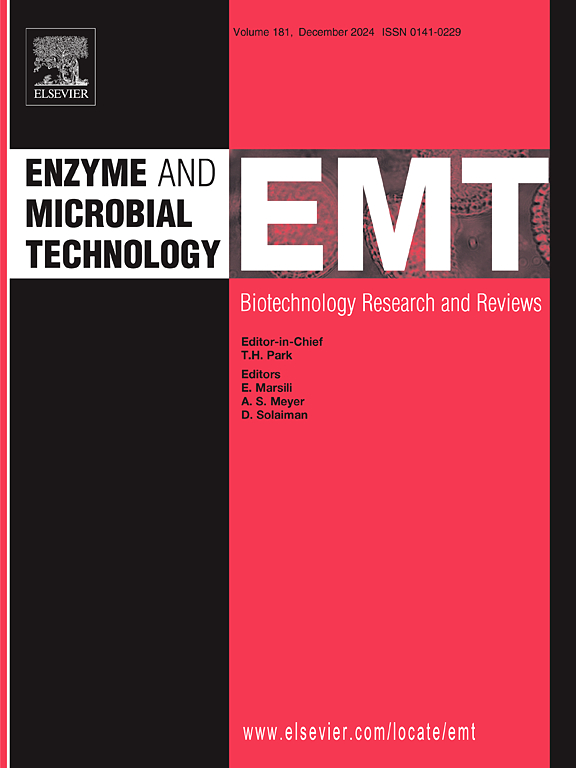双作用单工程混合结构启动子增强并将表达转化为Komagataella phaffii的多碳源调控系统
IF 3.7
3区 生物学
Q2 BIOTECHNOLOGY & APPLIED MICROBIOLOGY
引用次数: 0
摘要
乙醇、甘油、甲醇和醋酸酯是用作生化生产底物的可持续碳源(scs)。细胞同时受到多种外部刺激,而不是单一的刺激。SCSs作为底物和共底物必须被引导/重定向到发酵中。我们需要用多碳源诱导的全新工程启动子。这一概念进步的核心是开发新的方法,通过工程转录机制-元件与多个转录开关的相互作用将scs整合到发酵中,每个转录开关都设计有定向转录因子(TF)结合位点(TFBS)-TF相互作用。双作用单工程启动子(DASEPs)是在乙醇脱氢酶2 (ADH2)混合结构启动子布局上设计的,具有两个定向合成TFBS-TF相互作用,作为转录开关驱动scs诱导的上调和/或重连接的转录和表达。使用交叉酵母类比,我们预测了主TFs (i)乙醇和甲醇上的Cat8和(ii) scs上的Hap1和Hap2/3/4/5复合物。利用单作用单工程启动子(SASEPs)携带在碱基启动子ADH2结构上构建的合成TFBS-Cat8转录开关,我们在合成TFBS-Hap1和TFBS-Hap2/3/4/5转录开关的混合结构SASEP3布局上分别生成了DASEP1和DASEP2。在SCSs中,通过eGFP表达测量测试了DASEP1和DASEP2的性能,与SASEP3相比,分别优于sasep (i)在甘油上的8.2-和6.5倍,(ii)在2 % (v/v)乙醇上的2.7-和2.6倍,(iii)在1 % (v/v)乙醇上的3.9-和4.0倍,(iv)在1 % (v/v)甲醇上的3.6-和4.2倍,(v)在乙酸上的3.7-和2.8倍。相反,较低的细胞浓度表明eGFP表达对用DASEPs构建的代谢工程法菲氏K.细胞的代谢负担。本文章由计算机程序翻译,如有差异,请以英文原文为准。
Dual-acting single-engineered hybrid-architectured promoters enhance and convert expressions into multi-carbon source-regulated systems in Komagataella phaffii
Ethanol, glycerol, methanol, and acetate are sustainable carbon sources (SCSs) used as substrates for biochemical production. Cells are simultaneously exposed not to a single but multiple external stimuli. SCSs as substrates and co-substrates must be directed/redirected into fermentations. We need de novo engineered promoters inducible with multi-carbon sources. Core to this conceptual advance is the development of novel methodologies for integrating SCSs into fermentations through engineering transcriptional machinery-element interactions with multiple transcriptional switches, each designed with directed transcription factor (TF) binding site (TFBS)-TF interactions in Komagataella phaffii (Pichia pastoris). Dual-acting single-engineered promoters (DASEPs) were designed on alcohol dehydrogenase 2 (ADH2) hybrid-architectured promoter layout with two directed synthetic TFBS-TF interactions, function as transcriptional switches to drive SCS-induced upregulated- and/or rewired- transcription and expression. Using cross-yeast analogies, we predicted the master TFs (i) Cat8 on ethanol and methanol and (ii) Hap1 and Hap2/3/4/5 complex on the SCSs. Using single-acting single-engineered promoters (SASEPs) carrying synthetic TFBS-Cat8 transcriptional switch constructed on the base promoter ADH2 architecture, we generated DASEP1 and DASEP2 on the hybrid-architectured SASEP3 layout with synthetic TFBS-Hap1 and TFBS-Hap2/3/4/5 transcriptional switches, respectively. DASEP1 and DASEP2 performances tested by eGFP expression measurements in SCSs, outcompeted SASEPs and compared to SASEP3, respectively, (i) 8.2- and 6.5-fold on glycerol, (ii) 2.7- and 2.6-fold on 2 % (v/v) ethanol, (iii) 3.9- and 4.0-fold on 1 % (v/v) ethanol, (iv) 3.6- and 4.2-fold on 1 % (v/v) methanol, and (v) 3.7- and 2.8-fold on acetate. In contrast, lower cell concentrations indicated the metabolic burden of eGFP expression on the metabolic engineered K. phaffii cells constructed with DASEPs.
求助全文
通过发布文献求助,成功后即可免费获取论文全文。
去求助
来源期刊

Enzyme and Microbial Technology
生物-生物工程与应用微生物
CiteScore
7.60
自引率
5.90%
发文量
142
审稿时长
38 days
期刊介绍:
Enzyme and Microbial Technology is an international, peer-reviewed journal publishing original research and reviews, of biotechnological significance and novelty, on basic and applied aspects of the science and technology of processes involving the use of enzymes, micro-organisms, animal cells and plant cells.
We especially encourage submissions on:
Biocatalysis and the use of Directed Evolution in Synthetic Biology and Biotechnology
Biotechnological Production of New Bioactive Molecules, Biomaterials, Biopharmaceuticals, and Biofuels
New Imaging Techniques and Biosensors, especially as applicable to Healthcare and Systems Biology
New Biotechnological Approaches in Genomics, Proteomics and Metabolomics
Metabolic Engineering, Biomolecular Engineering and Nanobiotechnology
Manuscripts which report isolation, purification, immobilization or utilization of organisms or enzymes which are already well-described in the literature are not suitable for publication in EMT, unless their primary purpose is to report significant new findings or approaches which are of broad biotechnological importance. Similarly, manuscripts which report optimization studies on well-established processes are inappropriate. EMT does not accept papers dealing with mathematical modeling unless they report significant, new experimental data.
 求助内容:
求助内容: 应助结果提醒方式:
应助结果提醒方式:


